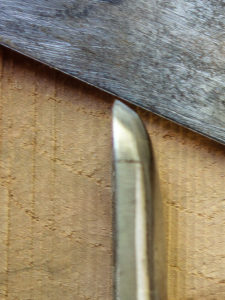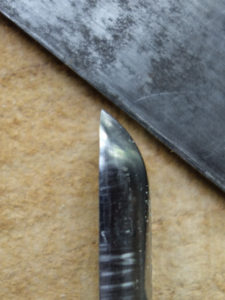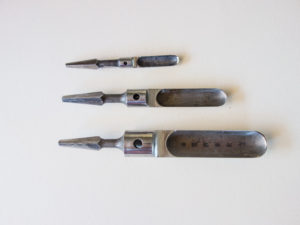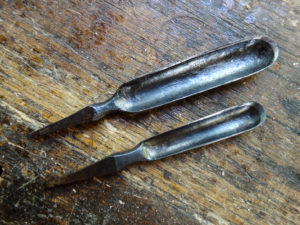Last summer Gramercy sent me some of their new spoon bits to review here on the blog. I’ve never gotten free stuff from a company before, but I guess there’s a first for everything. Don’t worry, I’m still as opinionated as ever.
Anyway, the next thing I knew I was using them to build a copy of a writing arm chair that was in Colonial Williamsburg’s collection. Then I was using them at the January symposium. And then Fine Woodworking asked me to review them, which I just finished doing. So now I’m finally going to review them here, more thoroughly this time.
I have had the privileged of using a handful of antique smith-made spoon bits, and they are a joy. The cutting angles at the tip all seem to fall within a narrow range, and these cutting angles are critical to the bit’s speed. This is where most bits made in living memory fail.
Below are the four makes of spoon bits that I own. The straight-edge at the top of the photo is parallel with the cutting angle at the tip of each bit:
As you can see, the Gramercy bit closely mimics the antique. They both cut very quickly, even though the antique isn’t all that sharp right now. Getting the cutting angles right is more important than how sharp the bit is (of course they cut better sharp).
The length of the Gramercy bits varies quite a bit. The 7/8″ bit has a 3.5“ cutting length, the 5/8“ bit has 2.5“ and the 3/8“ has a tiny 1.75“ Short bits like the 3/8″ were called doweling bits in some old catalogs. The short length makes sighting a little tricky (if accuracy is important).
Antique spoon bits taper from nose to shank. These antiques two taper quite a lot:
Old auger bits taper as well. This prevents wallowing out the hole’s mouth (or pulling up a chip) if you wobble as you’re drilling. I’ve heard a lot about using spoon bits to make a hole smaller at it’s mouth than at it’s bottom, but I’ve never seen any historical evidence for this. Maybe it’s out there, I don’t know.
Anyways, the Gramercy bits don’t taper at all, which is unfortunate. It’s also understandable – it must have been a nightmare to figure out how to machine these things, without trying to make them taper.
All in all, the Gramercy spoon bits may be the best bits made in living memory.






